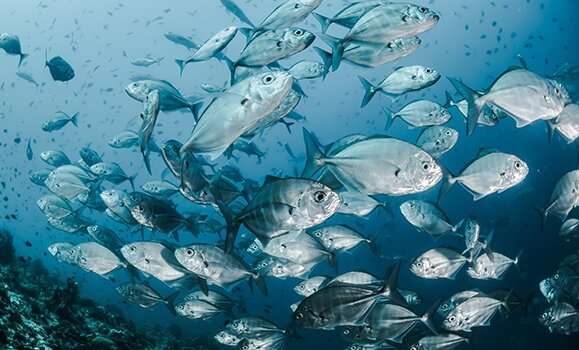This article has been reviewed according to Science X's editorial process and policies. Editors have highlighted the following attributes while ensuring the content's credibility:
fact-checked
trusted source
proofread
Researchers create portal of weird and wonderful fish sounds

Lurking beneath the ocean surface is a little-known chorus of sounds made up of everything from the grunts of a Bocon toadfish and the cough of an alewife to the rasp and ticks made by sablefish.
They are the surprising, yet distinct communications of a range of fish species that are not well chronicled or understood, despite their ability to provide critical information on habitats and which fish are occupying them.
To address that knowledge gap, an international team of researchers developed FishSounds, an online portal that lets users search through the first global inventory of fish sound information and a growing catalog of recordings. They hope it will enhance the understanding of fish behaviors, help track invasive species and monitor the marine environment's ecological health.
"FishSounds provides underwater acoustic researchers with a summary of everything the scientific community knows about whether a fish species makes noise, without requiring them to read through pages of text to find the answer," says Sarah Vela, senior data manager with Dalhousie University's MERIDIAN research group and lead developer on the innovative tool that brings the underwater soundscape to both academics and the public.
Visualizing sounds
The team, from Dalhousie University, the University of Victoria, the University of Florida, Simon Fraser University and Universidade de São Paulo in Brazil, recently outlined its work in a new paper published in Ecological Informatics and also updated the website.
The latest version adds a new visualization that includes statistics about fish species and the sounds they make on a map, using color to show trends like how fish are more talkative nearer the equator and the Atlantic is more communicative than the Pacific Ocean.
The authors caution that there's much more to discover, and insufficient research in the southern hemisphere and freshwater systems can skew statistics. Still, says Vela, visualizing the data can help identify exactly these holes in existing research, and seeing data on a map helps inspire different questions than seeing it in text or tables.
"Underwater sounds are a vital part of marine and freshwater ecosystems, and now we know that almost 1,200 species of fish contribute their distinctive sounds. Fish are the largest group of sound-producing vertebrates and have the greatest diversity of sound production mechanisms, but despite this, there was no inventory of all the fish species known to make sound and the types of sound they produce," says Audrey Looby, a doctoral candidate at the University of Florida who conducted a systematized review of literature in the field.
Co-author Kieran Cox of Simon Fraser University says this data will improve our knowledge of the contributions fish make to soundscapes and examine which species may be most affected by noise pollution.
An avid scuba diver, Dr. Cox remembers his first dive when the sound of parrotfish eating coral resonated over the reef.
"It's thrilling to know we are now archiving vital ecological information and making it freely available to the public. I feel like my younger self would be very proud of this effort," he says.
Free for all
One of the most common ways fish make sound is through stridulation, which involves two pieces of bony structure rubbing together like the clicking of teeth. Others make sound by using their swim bladder like a drum.
Emma Mensah, MERIDIAN's digital media specialist, produced the code for the map, designing it to be reusable and simple to deploy. A public repository for the map code is expected to be available this summer for use in other websites.
Mensah, an undergraduate student in the Faculty of Computer Science, says the project has been a valuable experience.
"Working on the interactive map was a fun, yet challenging experience. I learned new skills and made real-world connections with concepts I learned at Dalhousie to get where we are today. Seeing the work I've done be recognized is an awesome feeling, and it makes me happy to know many are benefiting from it."
The researchers reviewed more than 3,000 documents and extracted data from 830 studies to determine that 989 fish species have been shown to produce active sounds. MERIDIAN team members constructed the website as part of a Canadian Foundation of Innovation grant, ensuring all those fish voices and data are freely available online.
The site, the product of an international collaboration between researchers and developers from five organizations, allows users to search the data by taxa, sound, region and other filters. The lack of a database on global fish acoustics has been a major limitation in the field of aquatic soundscape, the researchers say. It may also help in national and international conversations on regulating noise pollution.
More information: Audrey Looby et al, FishSounds Version 1.0: A website for the compilation of fish sound production information and recordings, Ecological Informatics (2022). DOI: 10.1016/j.ecoinf.2022.101953
Provided by Dalhousie University


















